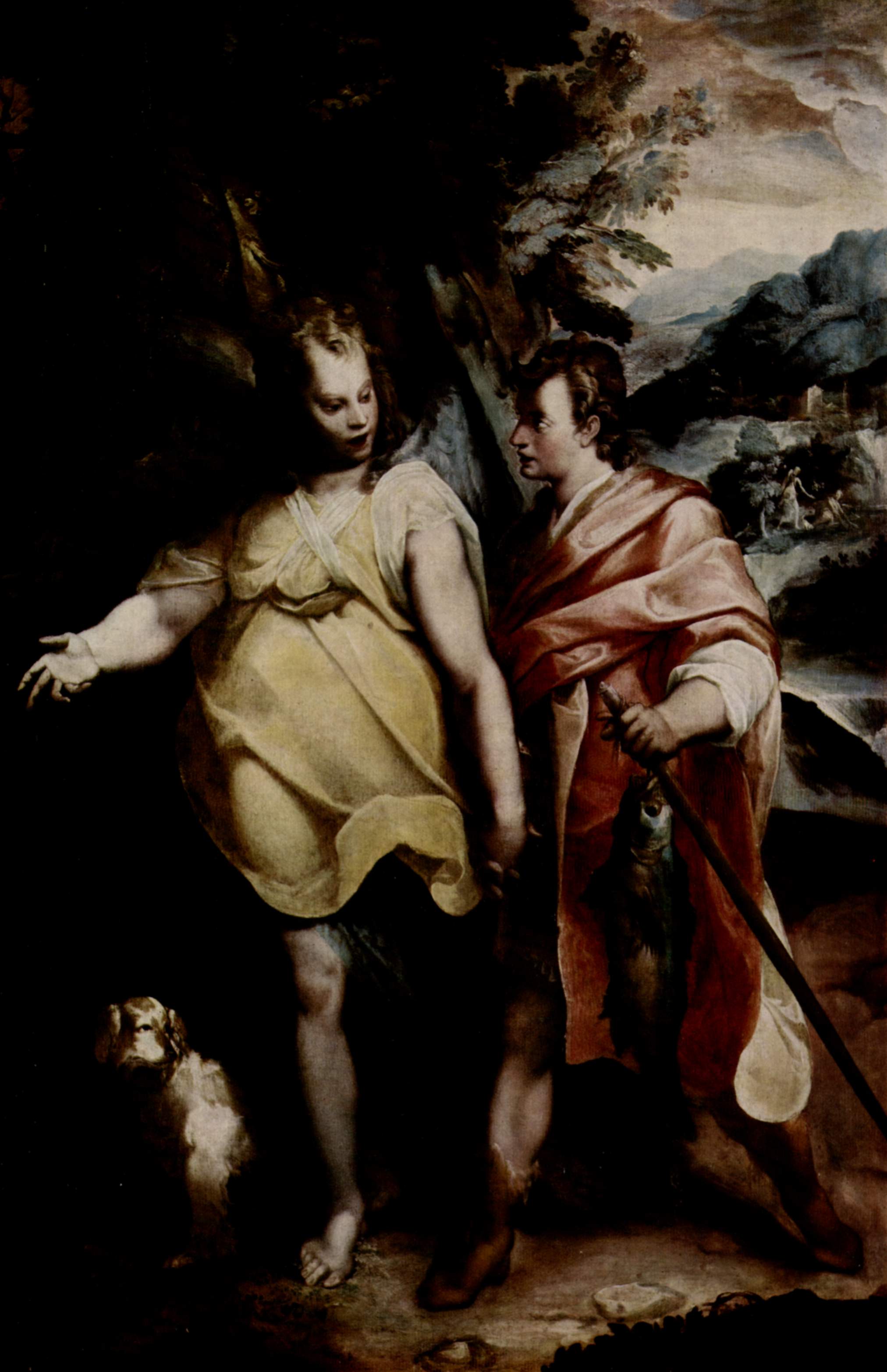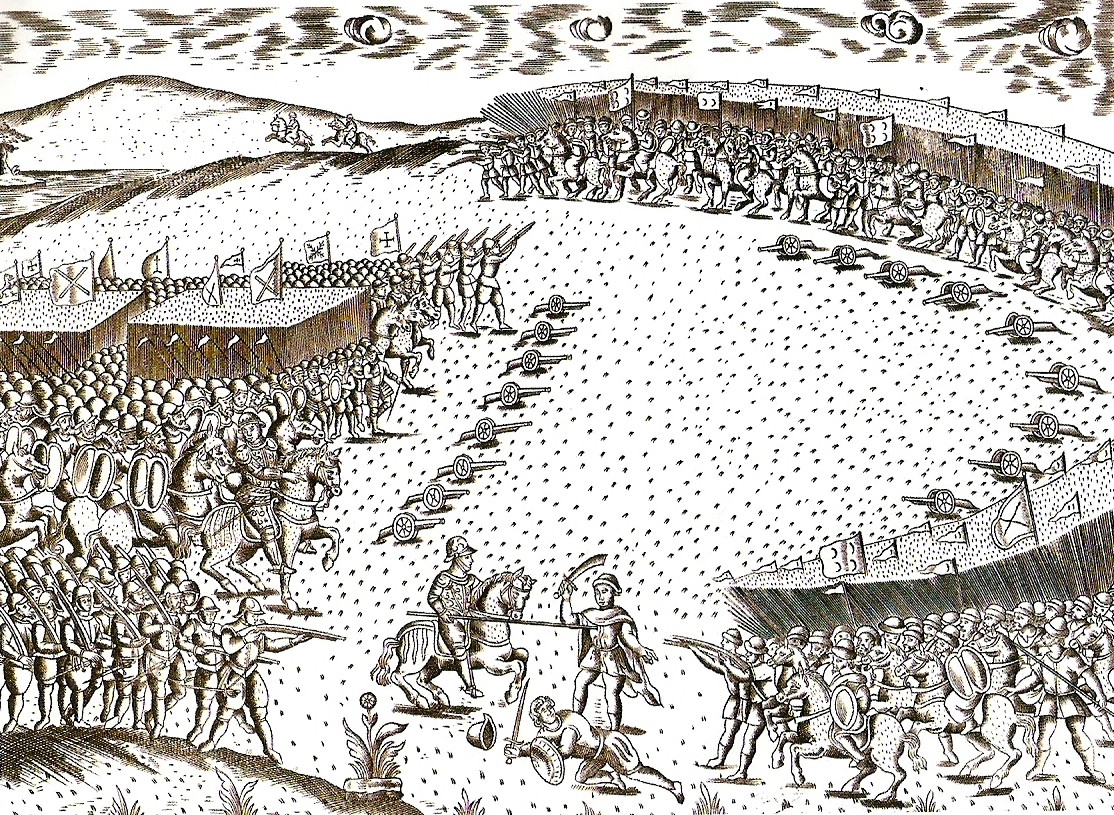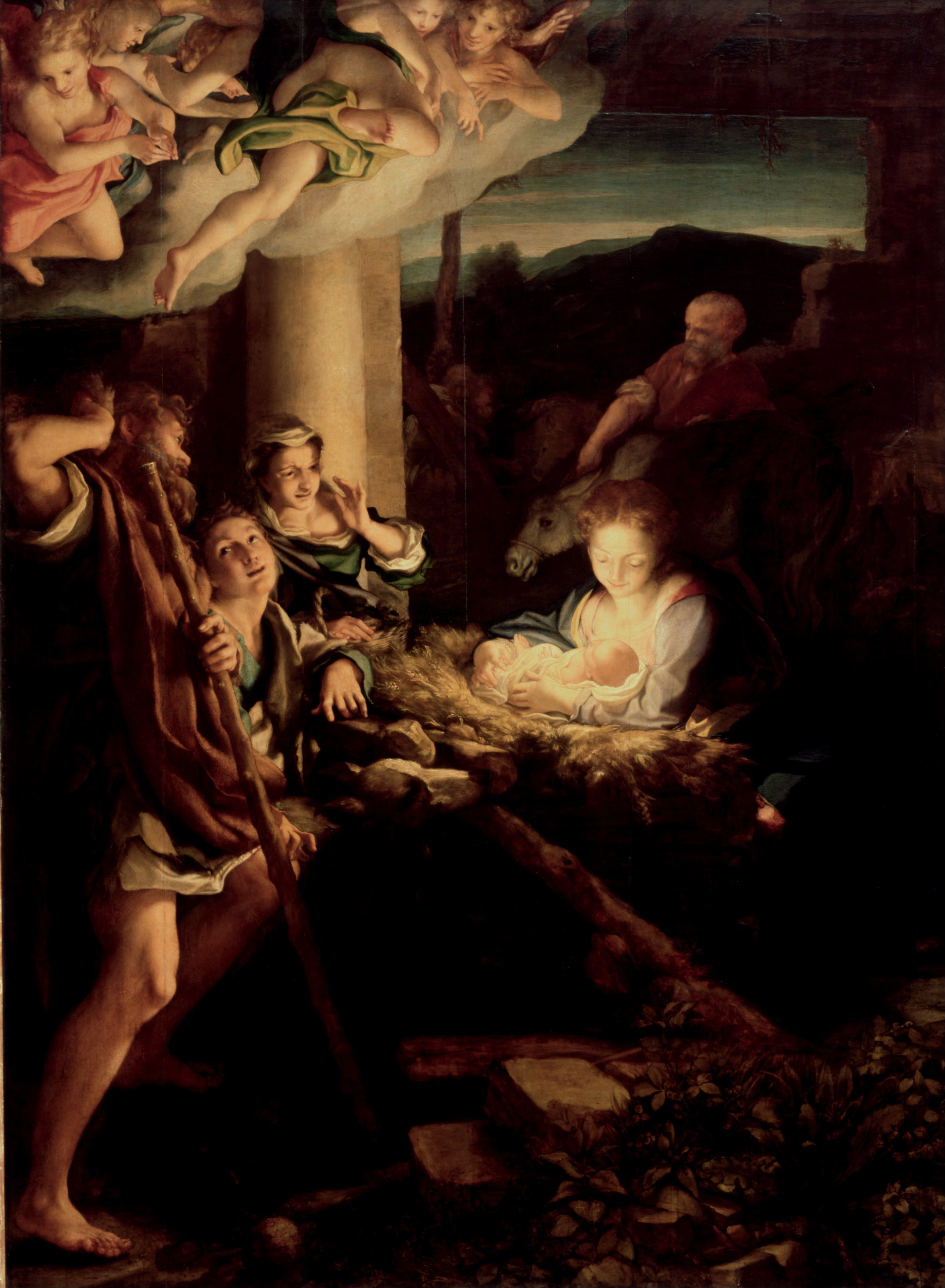|
Raffaellino Da Reggio
Raffaele Motta (1550 – 1578), known as Raffaellino da Reggio, was an Italian Mannerist style painter from Reggio Emilia, who mainly worked in Rome. He assimilated the style of Taddeo Zuccari and also developed more personal traits. In the last three years of his short life, he worked alongside Lorenzo Sabbatini in works for the Vatican commissioned by Gregory XIII. The Late Mannerist painter and historian Giovanni Baglione considered Raffaellino's early death a significant loss to art. Biography He was born at Codemondo near Reggio Emilia in 1550. According to his earliest biographer, Bonifacio Fantini, he was a builder's son who initially trained under Lelio Orsi in his studio in nearby Novellara, as well as with a medallist, Alfonso Ruspagiari. Fantini says he painted facades in Reggio Emilia and in Guastalla, where he worked for Cesare Gonzaga. By December 1570, he was in Rome, performing a commission for the cardinal Ippolito d’Este. In 1575, he worked with Giova ... [...More Info...] [...Related Items...] OR: [Wikipedia] [Google] [Baidu] |
Raffaello Motta 001
Raffaello, Raffaele or Raffaellino is an Italian given name. It usually refers to Raphael (a.k.a. Raffaello Sanzio da Urbino), an Italian painter and architect of the High Renaissance. Raffaello may also refer to: * Raffaello (confection), a confection * ''Raffaello'' MPLM, one of the three Multi-Purpose Logistics Modules used to transfer supplies to the International Space Station * SS Raffaello, an Italian ocean liner People People with the given name Raffaello or Raffaellino include: *Raffaello Carboni (1817–1875), Italian writer * Raffaello Ducceschi (born 1962), Italian race walker *Raffaello Fabretti (1620–1700), Italian antiquary * Raffaello Funghini (1929–2006), Italian catholic clergyman *Raffaello Gestro (1845–1936), Italian entomologist *Raffaello Maffei (1455–1522), Italian humanist, historian and theologian *Raffaello Matarazzo (1909–1966), Italian film-maker *Raffaello da Montelupo (1504–1566), sculptor and architect of the Italian Renaissance *Raffae ... [...More Info...] [...Related Items...] OR: [Wikipedia] [Google] [Baidu] |
Caprarola
Caprarola is a town and ''comune'' in the province of Viterbo, in the Lazio region of central Italy. The village is situated in a range of volcanic hills known as the Cimini Mounts. The town is home to the large Renaissance mansion or villa A villa is a type of house that was originally an ancient Roman upper class country house that provided an escape from urban life. Since its origins in the Roman villa, the idea and function of a villa have evolved considerably. After the f ... which dominates the surrounding country-side, Villa Farnese (or Villa Caprarola). Not to be confused with the Palazzo Farnese in Rome, it was initially built as a fortress, as the town and the surrounding area was a feud of the House of Farnese, by the cardinal Alessandro Farnese senio in 1530, according to a project of the architect Antonio da Sangallo the Younger. After only four years the project came to a halt when the cardinal was elected pope in 1534 under the name Paul III. Filmogr ... [...More Info...] [...Related Items...] OR: [Wikipedia] [Google] [Baidu] |
16th-century Italian Painters
The 16th century began with the Julian calendar, Julian year 1501 (represented by the Roman numerals MDI) and ended with either the Julian or the Gregorian calendar, Gregorian year 1600 (MDC), depending on the reckoning used (the Gregorian calendar introduced a lapse of 10 days in October 1582). The Renaissance in Italy and Europe saw the emergence of important artists, authors and scientists, and led to the foundation of important subjects which include accounting and political science. Copernicus proposed the Copernican heliocentrism, heliocentric universe, which was met with strong resistance, and Tycho Brahe refuted the theory of celestial spheres through observational measurement of the SN 1572, 1572 appearance of a Milky Way supernova. These events directly challenged the long-held notion of an immutable universe supported by Ptolemy and Aristotle, and led to major revolutions in astronomy and science. Galileo Galilei became a champion of the new sciences, invented the first ... [...More Info...] [...Related Items...] OR: [Wikipedia] [Google] [Baidu] |
Artists From Reggio Emilia
An artist is a person engaged in an activity related to creating art, practicing the arts, or demonstrating the work of art. The most common usage (in both everyday speech and academic discourse) refers to a practitioner in the visual arts only. However, the term is also often used in the entertainment business to refer to actors, musicians, singers, dancers and other performers, in which they are known as ''Artiste'' instead. ''Artiste'' (French) is a variant used in English in this context, but this use has become rare. The use of the term "artist" to describe writers is valid, but less common, and mostly restricted to contexts such as critics' reviews; "author" is generally used instead. Dictionary definitions The ''Oxford English Dictionary'' defines the older, broader meanings of the word "artist": * A learned person or Master of Arts * One who pursues a practical science, traditionally medicine, astrology, alchemy, chemistry * A follower of a pursuit in which skill co ... [...More Info...] [...Related Items...] OR: [Wikipedia] [Google] [Baidu] |
1578 Deaths
__NOTOC__ 1578 ( MDLXXVIII) was a common year starting on Wednesday in the Julian calendar. Events January–March * January 13 – The Siege of Gvozdansko ends in the Kingdom of Croatia as Ottoman Empire troops led by Ferhad Pasha Sokolović capture the fortress at Gvozdansko. * January 31 – Battle of Gembloux: Spanish forces under Don John of Austria and Alexander Farnese defeat the Dutch; Farnese begins to recover control of the French-speaking Southern Netherlands. * February 6 – Pope Gregory XIII issues the papal bull ''Illius fulti praesidio'' and creates the Diocese of Manila, the first Roman Catholic diocese in the Philippines, with Domingo de Salazar as the first Bishop of Manila. The diocese will be raised to the status of archdiocese on August 14, 1595. * February 8 – The city council of Amsterdam in the Netherlands ratifies a treaty placing the city under the authority of Willem, Prince of Orange, and joining the States of ... [...More Info...] [...Related Items...] OR: [Wikipedia] [Google] [Baidu] |
1550 Births
Year 1550 (Roman numerals, MDL) was a common year starting on Wednesday of the Julian calendar. Events January–March * January 6 – Spanish Captain Hernando de Santana founds the city of Valledupar, in modern-day Colombia. * February 7 – After a 1549–1550 papal conclave, 10-week conclave in Rome to elect a new Pope, Giovanni Maria Ciocchi del Monte, Bishop of Palestrina, is selected on the 61st ballot after Reginald Pole of England falls two votes short of winning. Ciocchi del Monte takes the name Pope Julius III and is crowned the next day, succeeding the late Pope Paul III. * February 25 – (10th day of 2nd month of Tenbun 19) In Ōita (city), Oita, Ōita Prefecture, an attack within the Ōtomo clan of Japanese samurai takes place after clan leader Ōtomo Yoshikazu seeks to disinherit his oldest son and to make his third son, Ōtomo Shioichimaru, as his designated successor. Supporters of the oldest son, Ōtomo Sōrin, Ōtomo Yoshishige, invade Y ... [...More Info...] [...Related Items...] OR: [Wikipedia] [Google] [Baidu] |
British Museum
The British Museum is a Museum, public museum dedicated to human history, art and culture located in the Bloomsbury area of London. Its permanent collection of eight million works is the largest in the world. It documents the story of human culture from its beginnings to the present.Among the national museums in London, sculpture and decorative art, decorative and applied art are in the Victoria and Albert Museum; the British Museum houses earlier art, non-Western art, prints and drawings. The National Gallery holds the national collection of Western European art to about 1900, while art of the 20th century on is at Tate Modern. Tate Britain holds British Art from 1500 onwards. Books, manuscripts and many works on paper are in the British Library. There are significant overlaps between the coverage of the various collections. Established in 1753, the British Museum was the first public national museum. In 2023, the museum received 5,820,860 visitors, 42% more than the previous y ... [...More Info...] [...Related Items...] OR: [Wikipedia] [Google] [Baidu] |
Artists In Biographies By Giovanni Baglione
''Le Vite de’ Pittori, Scultori et Architetti. Dal Pontificato di Gregorio XII del 1572 in fino a’ tempi di Papa Urbano VIII nel 1642'' ("Lives of the painters, sculptors, architects, from the papacies of Gregory XII in 1572 to Urban VIII in 1642") is an art history book by Giovanni Baglione, first published in 1642. It represents an encyclopedic compendium of biographies of the artists active in Rome during late Mannerism and early Baroque. Baglione (1566 – 1643) was a Mannerism, Late Mannerist and Baroque, Early Baroque painter and art historian, best remembered for his writings and his acrimonious involvement with the artist Caravaggio, by whom he was nonetheless greatly influenced. The book was first published in 1642, with a final version published in Naples in 1733, long after Baglione's death, with a biography of Salvator Rosa by Giovanni Battista Passeri as an appendix. The poet Ottavio Tronsarelli may have contributed a good deal of the text. The biographies ar ... [...More Info...] [...Related Items...] OR: [Wikipedia] [Google] [Baidu] |
Correggio
Antonio Allegri da Correggio (August 1489 – 5 March 1534), usually known as just Correggio (, also , , ), was an Italian Renaissance painter who was the foremost painter of the Parma school of the High Renaissance, who was responsible for some of the most vigorous and sensuous works of the sixteenth century. In his use of dynamic composition, illusionistic perspective and dramatic foreshortening, Correggio prefigured the Baroque art of the seventeenth century and the Rococo art of the eighteenth century. He is considered a master of chiaroscuro. Early life Antonio Allegri was born in Correggio, Italy, Correggio, a small town near Reggio Emilia. His date of birth is uncertain (around 1489). His father was a merchant. Otherwise little is known about Correggio's early life or training. It is, however, often assumed that he had his first artistic education from his father's brother, the painter Lorenzo Allegri (painter), Lorenzo Allegri. In 1503–1505, he was apprenticed to Fran ... [...More Info...] [...Related Items...] OR: [Wikipedia] [Google] [Baidu] |
Oxford Art Online
Oxford Art Online is an Oxford University Press Oxford University Press (OUP) is the publishing house of the University of Oxford. It is the largest university press in the world. Its first book was printed in Oxford in 1478, with the Press officially granted the legal right to print books ... online gateway into art research, which was launched in 2008. It provides access to several online art reference works, including Grove Art Online (originally published in 1996 in a print version, ''The Dictionary of Art''), the online version of the '' Benezit Dictionary of Artists'', and ''The Oxford Companion to Western Art''. It also provides access to other Oxford art reference works, including the '' Encyclopedia of Aesthetics'' (2nd edition), and ''The Concise Oxford Dictionary of Art Terms''. The site was updated on 1 December 2017 to enhance page design, search tools, linking, and media capabilities. [...More Info...] [...Related Items...] OR: [Wikipedia] [Google] [Baidu] |
The Burlington Magazine
''The Burlington Magazine'' is a monthly publication that covers the fine and decorative arts of all periods. Established in 1903, it is the longest running art journal in the English language. It has been published by a charitable organisation since 1986. Since 2018, it has also published the online, open-access contemporary art platform, ''Burlington Contemporary''. History The magazine was established in 1903 by a group of art historians and connoisseurs which included Roger Fry, Herbert Horne, Bernard Berenson, and Charles Holmes. Its most esteemed editors have been Roger Fry (1909–1919), Herbert Read (1933–1939), and Benedict Nicolson (1948–1978). The journal's structure was loosely based on its contemporary British publication '' The Connoisseur'', which was mainly aimed at collectors and had firm connections with the art trade. ''The Burlington Magazine'', however, added to this late Victorian tradition of market-based criticism new elements of historical resea ... [...More Info...] [...Related Items...] OR: [Wikipedia] [Google] [Baidu] |
Federico Zuccari
Federico Zuccaro, also known as Federico Zuccari and Federigo Zucchero ( July/August 1609), was an Italian painter, draughtsman, architect and writer. He worked in various cities in Italy, as well as in other countries such as Spain, France, the Spanish Netherlands and England.. He was an important representative of late Mannerism in Italian art.. Life and work Zuccaro was born in Sant'Angelo in Vado, near Urbino (Marche), then in the Duchy of Urbino. His parents were the painter Ottaviano de Zucharellis, who changed his surname to Zuccaro in 1569, and Antonia Neri. He was the third child of eight. His siblings were called Taddeo, Bartolomea, Federico, Iacopo, Lucio, Maurizio, Aloysio and Marco Antonio. In 1550, when he was barely 11 years old, his parents brought him to Rome to study law but Federico preferred a career in art. He trained and worked in the workshop of his elder brother Taddeo who had become a successful painter in Rome. He became quickly integrated into the ... [...More Info...] [...Related Items...] OR: [Wikipedia] [Google] [Baidu] |








